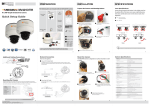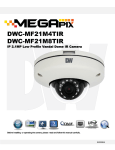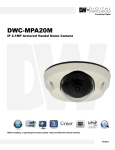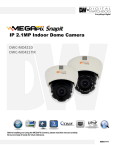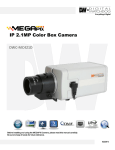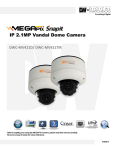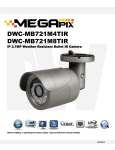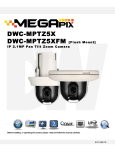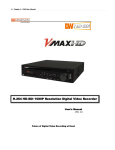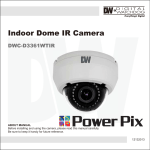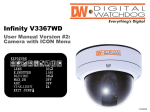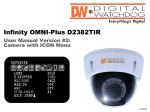Download Digital Watchdog MEGApix DWC-MF21M8TIR Setup guide
Transcript
Template Sheet Template Sheet PREPARATION INSTALLATION The following items are included with your MEGApix Camera DWC-MF21M4TIR DWC-MF21M8TIR DWC-MF21M4TIR DWC-MF21M8TIR IP 2.1MP Flush Mount Vandal Dome IR Camera Quick Start Guide Quick Setup Guide CD (Manual & Software) IP 2.1MP Low Profile Vandal Dome IR Camera Quick Setup Guide 2 Mounting Nuts & 2 Mounting Screws Metal Mount Plate L-Wrench Mounting Template for Camera and Metal Mount Plate 2 3 Screws & 3 Dry Wall Anchors Low Profile Vandal Dome IR Camera - 12VDC Power - RJ45 Network Thank you for purchasing Digital Watchdog’s MEApix Flat Vandal Dome Camera. Before installing the camera, please verify your model and read this guide carefully. Easy Camera Installation Installation Using Mount Plate 1. Detach the camera’s cover dome from the camera’s module by unscrewing the three cover dome screws using the L-Wrench. 2. Use the camera or mounting template to mark and drill the necessary holes in the wall or ceiling. 3. Pull wires through and make connections. 4. Using three (3) included screws mount and secure the camera to the wall or ceiling. 5. Secure the camera’s cover dome onto the camera base to complete the installation. 1. Detach the camera’s cover dome from the camera’s module by unscrewing the three cover dome screws. 2. Using the metal mount plate, mark and drill the necessary holes in the wall or ceiling. 3. Pull wires through and make connections. 4. Using the three (3) included screws, mount and secure the camera to the wall or ceiling. 5. Attach the camera base to the metal mount by snapping it into place using the two metal handles. 6. Secure the camera’s cover dome onto the camera base to complete the installation. Installation Using Mount Bolt & Nut 1. Detach the camera’s cover dome from the camera’s module by unscrewing the three cover dome screws. 2. Using the camera or mounting template, mark and drill the necessary holes in the wall or ceiling. 3. Secure the two long mounting screws to the camera’s base. 4. Pull wires through and make connections. 5. Mount the camera to the mounting surface using the 2 mounting nuts. 6. Secure the camera’s cover dome onto the camera base to complete the installation. 2 Parts and Description Tilt Stopper Screw Lens Recommended Settings There are two options.* Camera Default Color Settings Using a PoE-Enabled Switch To adjust the camera’s orientation: 1. Loosen the tilt stopper screw at the base of the camera’s Gibmal by rotating it counter clock-wise. 2. Move the camera to the desired angle. 3. Secure the camera’s lens position by screwing the tilt stopper screw clock-wise. Camera Specifications Micro SD Card Slot DC Power Cable RJ-45 Cable Resetting the Camera 2 Pressing the reset button on the camera’s control board for five (5) seconds will initialize all environmental variables to factory default. Previous setup for IP default, time, etcetera will be deleted. If a system IP address is lost, reset the camera back to factory default.The following are the default network settings: 4 SPECIFICATIONS Please refer to the table below for the default camera settings. You can reset the camera’s settings to its default color settings by pressing the ‘Default’ button at the bottom of the screen. The MEGApix Camera is PoE-compliant, allowing transmission of power and data via a single ethernet cable. Follow the illustrations below to connect the camera to a PoE-enabled switch using an ethernet cable. Reset Button Adjusting the Camera’s Angle 3 Network Connection 1 INSTALLATION IMAGE Image Sensor Effective Pixels Minimum Scene Illumination LENS Focal Length F2.0 (30IRE): 2.4 Lux [Color], F2.0 (30IRE): 0.5 Lux [B/W] Zoom Lens Type IR Distance Angle of View NETWORK LAN Video Compression Type Resolution Frame Rate 12x Digitzl Zoom Fixed Lens 30ft Range IR Horizontal: 42o Wide Angle If a PoE-enabled switch is not used, use a power adaptor to connect the MEGAPIX Camera to a Non-PoE switch. DHCP 192.168.1.123 255.255.255.0 192.168.1.123 7000 80 7001 Dual-Stream at Different Rates and Resolutions IPv4, IPv6 Protocol TCP/IP, HTTP, DHCP, PPPoE, ICMP, ARP, RARP, RTSP, NTP, UDP, Multicast 5 Users ONVIF Conformance Yes Web Viewer OS: Windows XP / Vista / 7, MAC OS Browser: Internet Explorer, Chrome, Firefox, Safari NxMS, DW Spectrum, Pivot Video Management Software Memory Slot Frequent use may cause a System Error TEL: (866) 446-3595 www.Digital-Watchdog.com / [email protected] Technical Support Hours: Monday-Friday 9:00AM to 8:00PM EST Reset Button ! 5 20 140122 6 7 802.3 Compliance 10/100 LAN H.264, MPEG4, MJPEG (Super Fine~Low) 1920X1080 (16:9) ~ 320X240 (4:3) Up to 30fps at All Resolutions Streaming Capability ENVIRONMENTAL Operating Temperature/ Humidity IP Mode IP Address Subnet Mask Gateway Command Port HTTP Port Live Port 4.0mm [DWC-MF21M4TIR] / 8.0mm [DWC-MF21M8TIR] IP Maximum User Access Using a Non-PoE Switch 1/2.8” Sony CMOS Sensor 1920 (H) X 1080 (V) 24 hours recording to Micro SDHC Card (4GB-32GB) Card Not Included* -10oC ~ 50oC (14oF ~ 122oF) Operating Humidity IP Rating Other Certifications ELECTRICAL Power Requirement Power Consumption MECHANICAL Material Dimensions Less than 90% (Non-Condensing) IP66 (Protects against dust and high pressure water) CE, FCC, RoHS Weight 1.0 lbs DC 12V, PoE (IEEE802.3af Class 2) 3.6W, 300mA / LED ON: 4.3W, 360mA Aluminum Housing 125 x 74.3 mm (4.9 X 2.9 in) 8 MEGApix CAMERA SETUP Installing IP Finder IP Finder searches for all the available network devices on your local area network. 1 Install IP Finder to find your MEGApix Camera on the local network. The IP Finder software is on the included mini-CD. Run IP Finder and install onto your PC. 2 When setup is complete, launch the IP Finder software. 3 To find your MEGApix camera, click Search button. Your MEGApix camera will appear as “DWC-MF21M4TIR.” 4 To access the camera directly via Internet Explorer, select the desired device and click Web Connect. 5 To change basic network settings through the IP Finder software, select the desired device and click Configuration. Setting the Camera on IP Finder Setting the Camera on IP Finder Accessing the Camera Set the Camera for Internal Use If you wish to connect your MEGApix Camera internally from within the same network: 1 Find your MEGApix Camera on IP Finder software and click Configuration. Select an IP Configuration Mode - DHCP, PPPoE, or Static - that is 2 available to you. Recommended Setting is DHCP.* 3 If you wish to use DDNS, select the Use DDNS option. See page 10 for further information. 4 When the setup is complete, select Apply. 5 Then, select Reboot button. The rebooting process usually takes up to a minute. 6 Select Exit. 7 On the IP Finder window, select Search and comfirm that your changes have been made. User can use the IP Finder software to setup the basic network Accessing the Camera settings. 1 3 5 Webviewer Specifications 10 CPU RAM HDD OS Resolution Intel P4 2.0GHz Dual Core More than 1GB 200GB Required for Saving Clip Image Microsoft Windows XP or Higher Higher than 1024X768 Alarm Status Computer’s Date & Time Camera’s Name Full Screen Mode Camera’s Time Access Setup Menu Export Camera’s Display as JPEG Print Camera’s Current Display Start/ Stop Instant Recording Stream’s Name Camera’s IP Address Stream Control Enter the IP address of the camera on the Internet Explorer window. Example: http://192.168.1.123 (Factory Default) 2 Enter Username and Password. Username: admin Password: admin 3 The web browser will ask to install Active-X Control. Once it has been installed, Internet Explorer will display video images from the camera. 1 Minimum Requirements for PC Export & Print Instant Recording Instantly record live video to your local drive. 4 3 Static IP: This option will assign a static (fixed) IP to your camera. A static IP address will prevent the network from changing the camera’s IP address and make it easier to access, especially when the camera is on a large network and accessed by multiple users. Contact your Internet Service Provider for more information.* Use DDNS: Check this option to use DDNS (Dynamic DNS). DDNS 4 allows users to setup a unique URL for the IP camera. To use DDNS, you must register for a DDNS ID from a DDNS Hosting Service.* Port: This section displays all the port numbers that are required for 5 remote communication. Set the Camera for External Use If you wish to connect your MEGApix Camera to an external network, please use Static IP. 1 Find your MEGApix Camera on IP Finder software and click Configuration. Select Static IP Configuration Mode. 2 3 If you wish to use DDNS, select the Use DDNS option. See page 10 for further information. 4 When the setup is complete, select Apply. 5 Then, select Reboot button. The rebooting process usually takes up to a minute. 6 Select Exit. 7 On the IP Finder window, select Search and comfirm that your changes have been made. 9 2 1 DHCP: If DHCP is selected, an IP address will automatically be assigned to the camera. If your network does not support DHCP, a default IP address and subnet mask will automatically be assigned. 2 PPPoE: Select this option, when you use WAN service or a PPPoE-based internet service. Contact your Internet Service Provider for a User ID and Password.* Main Display Area 11 First Stream & Second Stream ! The web viewer can also be accessed via Google Chrome, Firefox Mozilla and Safari if one of the streams is set to MJPEG 12 SD Card Installation & Setup The MEGApix cameras offer local backup in case of network loss. Setting up an Emergency Recording Schedule: 2 Select Single Day/ Multiple Day Schedule Setup Recording Options: Continuous, Motion, Sensor, No Recording 1 3 Pre & Post Alarm Recording Setup 4 Overwrite SD Card when Full 5 6 Record only Key Frames (Space saving) Exporting Backup Data from the SD Card: 1 2 To Setup Instant Recording Select the Record button. Indicate where you want the videos to be saved. Setup the duration of the instant recording. You can record up to 120 seconds of live video. When setup is complete, click OK to save changes or Cancel to cancel any changes. To Start and Stop Instant Recording To Start, right-click anywhere on the display screen. Select Start Rec. The icon on the top right of the screen will change to INSTANT. To Stop, right-click anywhere on the display screen. Select Stop Rec. The video will be displayed in the designated folder when recording is complete. TEL: (866) 446-3595 www.Digital-Watchdog.com / [email protected] Technical Support Hours: Monday-Friday 9:00AM to 8:00PM EST 13 To Export an Image: 1. Select the Export Image button. A ‘Save As’ window will appear. 2. Select the folder you wish to Save in and type a File Name. To Print an Image: 1. Select the Print button. The Print Preview window will appear. 2. Adjust the orientation of the screenshot. 2 3. Zoom in on a portion of an image prior to printing or select the image’s scale on the page. 4. To print information about the screenshot, select View Title. 5. To add a memo for the screenshot, select Page Option. 6. Go to Printer Setup to select the printer and manage printer properties. Select Print to print the page, or Close to cancel the print. 14 3 Configure two different stream settings (First Stream and Second Stream) for monitoring and recording. Second Stream is used to record on Motion Detection and the SD card local backup. 1 Click Setup to adjust the two available stream settings: First Steam and Second Stream. The two streams can differ in Resolution, Compression Type, Data Transfer Speed, and Framerate. 2 On the main monitoring page, user can view the camera with the First Stream settings or the Second Stream Settings. Below the display screen, click First Stream button to view the camera with the First Stream settings, and click Second Stream button to view the camera with the Second Stream settings. *Stream settings are disabled if accessing the camera from the DW Spectrum software. 15 Backup Date & Time Setup Directory Drive Availble Data 5 4 Selected Data for Backup Left Click to indicate start time. Right Click to indicate end time. SD card is for Recording Loss emergency recording. ! 16


